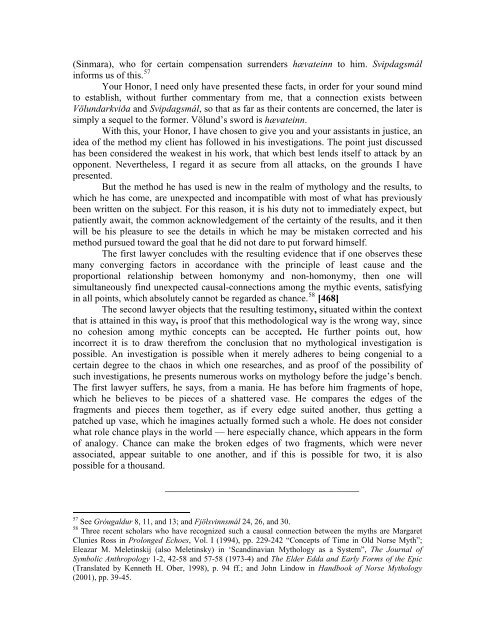Towards a Method of Mythology - Germanic Mythology
Towards a Method of Mythology - Germanic Mythology
Towards a Method of Mythology - Germanic Mythology
You also want an ePaper? Increase the reach of your titles
YUMPU automatically turns print PDFs into web optimized ePapers that Google loves.
(Sinmara), who for certain compensation surrenders hævateinn to him. Svipdagsmál<br />
informs us <strong>of</strong> this. 57<br />
Your Honor, I need only have presented these facts, in order for your sound mind<br />
to establish, without further commentary from me, that a connection exists between<br />
Völundarkviða and Svipdagsmál, so that as far as their contents are concerned, the later is<br />
simply a sequel to the former. Völund’s sword is hævateinn.<br />
With this, your Honor, I have chosen to give you and your assistants in justice, an<br />
idea <strong>of</strong> the method my client has followed in his investigations. The point just discussed<br />
has been considered the weakest in his work, that which best lends itself to attack by an<br />
opponent. Nevertheless, I regard it as secure from all attacks, on the grounds I have<br />
presented.<br />
But the method he has used is new in the realm <strong>of</strong> mythology and the results, to<br />
which he has come, are unexpected and incompatible with most <strong>of</strong> what has previously<br />
been written on the subject. For this reason, it is his duty not to immediately expect, but<br />
patiently await, the common acknowledgement <strong>of</strong> the certainty <strong>of</strong> the results, and it then<br />
will be his pleasure to see the details in which he may be mistaken corrected and his<br />
method pursued toward the goal that he did not dare to put forward himself.<br />
The first lawyer concludes with the resulting evidence that if one observes these<br />
many converging factors in accordance with the principle <strong>of</strong> least cause and the<br />
proportional relationship between homonymy and non-homonymy, then one will<br />
simultaneously find unexpected causal-connections among the mythic events, satisfying<br />
in all points, which absolutely cannot be regarded as chance. 58 [468]<br />
The second lawyer objects that the resulting testimony, situated within the context<br />
that is attained in this way, is pro<strong>of</strong> that this methodological way is the wrong way, since<br />
no cohesion among mythic concepts can be accepted. He further points out, how<br />
incorrect it is to draw therefrom the conclusion that no mythological investigation is<br />
possible. An investigation is possible when it merely adheres to being congenial to a<br />
certain degree to the chaos in which one researches, and as pro<strong>of</strong> <strong>of</strong> the possibility <strong>of</strong><br />
such investigations, he presents numerous works on mythology before the judge’s bench.<br />
The first lawyer suffers, he says, from a mania. He has before him fragments <strong>of</strong> hope,<br />
which he believes to be pieces <strong>of</strong> a shattered vase. He compares the edges <strong>of</strong> the<br />
fragments and pieces them together, as if every edge suited another, thus getting a<br />
patched up vase, which he imagines actually formed such a whole. He does not consider<br />
what role chance plays in the world — here especially chance, which appears in the form<br />
<strong>of</strong> analogy. Chance can make the broken edges <strong>of</strong> two fragments, which were never<br />
associated, appear suitable to one another, and if this is possible for two, it is also<br />
possible for a thousand.<br />
________________________________________<br />
57 See Gróugaldur 8, 11, and 13; and Fjölsvinnsmál 24, 26, and 30.<br />
58 Three recent scholars who have recognized such a causal connection between the myths are Margaret<br />
Clunies Ross in Prolonged Echoes, Vol. I (1994), pp. 229-242 “Concepts <strong>of</strong> Time in Old Norse Myth”;<br />
Eleazar M. Meletinskij (also Meletinsky) in ‘Scandinavian <strong>Mythology</strong> as a System”, The Journal <strong>of</strong><br />
Symbolic Anthropology 1-2, 42-58 and 57-58 (1973-4) and The Elder Edda and Early Forms <strong>of</strong> the Epic<br />
(Translated by Kenneth H. Ober, 1998), p. 94 ff.; and John Lindow in Handbook <strong>of</strong> Norse <strong>Mythology</strong><br />
(2001), pp. 39-45.
















